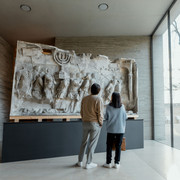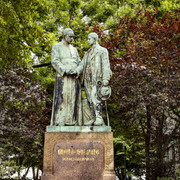Cologne, Minoritenstraße 13 was the address of the renowned luxurious fashion house Franz Sauer until 2016, which, as a family business, stood for the highest quality clothing for 175 years. That here - in the building from 1989 with its facade of Worzeldorfer quartzite, marble floors, and a generously spacious cascading staircase across all floors - the Cologne City Museum found its new home, is the first unique feature of this museum. The second unique feature is the concept, which, like this place, does not conform to the common opinion of classical museum design—and evokes emotions, curiosity, desires, opinions, and joy—among Cologne residents and visitors.
Very modern and progressively designed, the Cologne City Museum presents around 650 objects to view, play with, listen to, and watch. Historical exhibits stand alongside digital formats, interactive stations next to donations from original life in Cologne, all conceptualized according to a convincing multi-perspective approach to city history.
Having fun and getting involved personally is explicitly encouraged! All of this is possible as part of a guided tour in various languages as well.
Compared to the previous location at the Zeughaus, the building with the winged car on the roof, the museum now has significantly less space for its permanent exhibition: only 700 sqm instead of 2000 sqm—which means only room for selected exhibits. The others are stored in depots. The gain in other respects is, however, immense: instead of classic chronologies and century rooms, there is more room for contemporary, dynamic concepts. Certainly, one or the other exhibit will be awakened from its depot sleep in the course of time.
The area "What makes us angry?" takes you on a journey through triggers for intense emotions: whether the Anno uprising of 1074 or the KVB sit-in of 1966. In "What do we hope for?" you can explore how people's hope has changed over the centuries. In "What connects us," it's naturally about connectedness but also very practical connections of spatial concretes—like the Rhine bridges.
The concept "A Museum for Everyone" is also reflected architecturally in the barrier-free accessibility: for example, with elevators, seating areas, as well as areas with wheelchair accessibility.
As early as 1912, the former city Arsenal was considered a new, sole museum location, but the Great Depression and World War delayed the move-in. Only in 1958, could the Cologne City Museum open its permanent exhibition and present it to its visitors until the year 2017.
Then water damage necessitated another move to the interim location at Fashion House Franz Sauer, the place where you can visit it today. The city museum also includes a publicly accessible library with approximately 50,000 media units around Cologne's history, as well as illustrated Rhine travel descriptions and old prints.
Very modern and progressively designed, the Cologne City Museum presents around 650 objects to view, play with, listen to, and watch. Historical exhibits stand alongside digital formats, interactive stations next to donations from original life in Cologne, all conceptualized according to a convincing multi-perspective approach to city history.
Having fun and getting involved personally is explicitly encouraged! All of this is possible as part of a guided tour in various languages as well.
From 2000 sqm to 700 sqm: Quality over Quantity
Founded in 1888, the collection of the Cologne City Museum today encompasses around 500,000 various objects—from lapel pins to carnival floats. The oldest exhibits date back to around 1000 AD, the most recent from the last few years, such as the Corona mailbox from Cologne children during lockdown times. City history is history, politics, economy, culture, and also everyday life—and every object can tell its story: whether it's one of the oldest preserved armory horses, the fan jacket of 1. FC Köln, the historical Cologne city model from 1913—which is also an augmented reality station—the pink tropical suit of Cologne comedian Dirk Bach, the original figure of the taylors's wife of the Heinzelmännchen fountain or the "city map for men" as well as the first video game console developed in Germany in the 70s, the VC 4000.Compared to the previous location at the Zeughaus, the building with the winged car on the roof, the museum now has significantly less space for its permanent exhibition: only 700 sqm instead of 2000 sqm—which means only room for selected exhibits. The others are stored in depots. The gain in other respects is, however, immense: instead of classic chronologies and century rooms, there is more room for contemporary, dynamic concepts. Certainly, one or the other exhibit will be awakened from its depot sleep in the course of time.
The Museum Concept: 8 Questions that Occupy and Touch Us
Our emotions shape us and have always shaped cities and thus ultimately also "city history". On this intellectual basis, eight areas were created in the Cologne City Museum, each titled with a question; as intellectual impulses, these questions prompt reflection and personal involvement.Believing, Hoping, Loving, Desiring, Moving, Fearing, Outraging, Connecting
In "What do we believe in?" it’s naturally about religion, but also about football or money. In "What scares us?" you encounter topics such as war, the Nazi era, terrorism, or even the Corona pandemic. In "What do we desire?" you deal with sexuality, moral concepts, as well as the entertainment industry from the Middle Ages to modern times. The area "What do we love?" then touches your heart and touches on love stories, homeland, music, and world-famous Cologne brands like Cologne Cathedral or the fragrance water 4711. In "What moves us?" you encounter not only means of transportation from past centuries but also the emotional impulses of the soul—in the sense of moving moments.The area "What makes us angry?" takes you on a journey through triggers for intense emotions: whether the Anno uprising of 1074 or the KVB sit-in of 1966. In "What do we hope for?" you can explore how people's hope has changed over the centuries. In "What connects us," it's naturally about connectedness but also very practical connections of spatial concretes—like the Rhine bridges.
Accessibility and Inclusive Content Mediation in the Museum "for Everyone"
Conceptually, special attention was paid to inclusive content mediation: therefore, you will find the most important texts additionally in Braille, many graphics are tactilely graspable, and hands-on stations are installed. Guided tours with the multimedia guide are also available for people with visual impairments, as well as videos in German Sign Language.The concept "A Museum for Everyone" is also reflected architecturally in the barrier-free accessibility: for example, with elevators, seating areas, as well as areas with wheelchair accessibility.
Museum Locations: From Hahnentor to Zeughaus to Fashion House
As with other Cologne museums, the collection of Ferdinand Franz Wallraf formed a rich basis for the Cologne City Museum. In 1888, city history was first exhibited in the Hahnentorburg and a few years later additionally in the Eigelstein City Gate.As early as 1912, the former city Arsenal was considered a new, sole museum location, but the Great Depression and World War delayed the move-in. Only in 1958, could the Cologne City Museum open its permanent exhibition and present it to its visitors until the year 2017.
Then water damage necessitated another move to the interim location at Fashion House Franz Sauer, the place where you can visit it today. The city museum also includes a publicly accessible library with approximately 50,000 media units around Cologne's history, as well as illustrated Rhine travel descriptions and old prints.
Museum Locations: From Hahnentor to Zeughaus to Fashion House
With its location right in the city center - in close proximity to the cathedral, Hohe Strasse, Früh, the Museum of Applied Arts, and Kolumba - the Cologne City Museum is practically always nearby when you are in the city. It thus offers a central opportunity to delve into your emotions and the collective urban experience in a mentally adventurous way.Useful Information
Openings
1st Thursday of the month open 10-22 (except public holidays)
Dayoff: Monday
Price info
Price adult: €5.00
Price reduced: €3.00
Free admission for Cologne residents on KölnTag, for further discounts and information see website
Eligibility
Bad Weather Offer
Suitable for any weather
for Groups
for Class
for families
for individual guests
Suitable for the Elderly
Parking facilities
The walk from Cologne Central Station to the Cologne City Museum takes about 6 minutes.
Nearby











